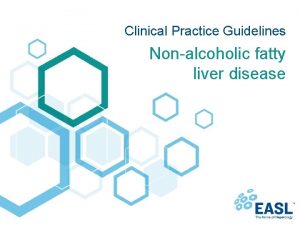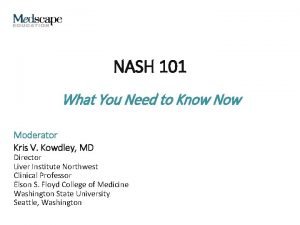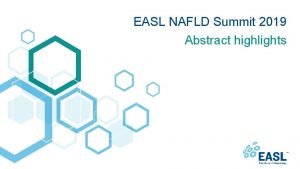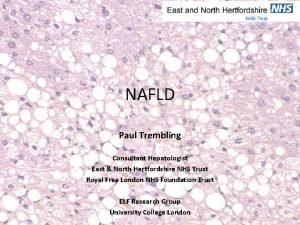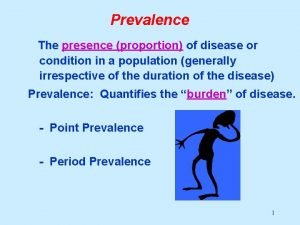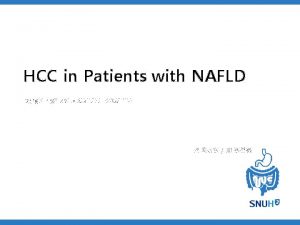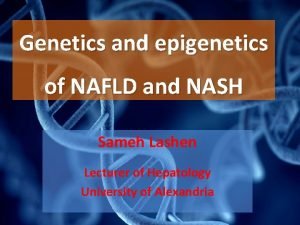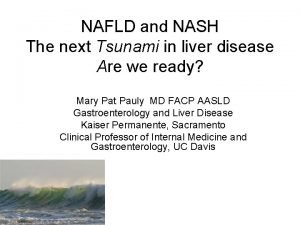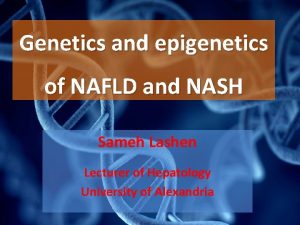Definitions epidemiology NAFLD NAFL NASH Disease Definition Entire










- Slides: 10

Definitions & epidemiology

NAFLD, NAFL, NASH? Disease Definition > Entire spectrum of fatty liver disease in individuals without significant alcohol consumption > From fatty liver to hepatic steatosis to cirrhosis > Hepatic steatosis ≥ 5% > No evidence of hepatocellular injury (ballooning) > No evidence of fibrosis > Hepatic steatosis ≥ 5% > Liver inflammation > Hepatocyte injury (ballooning) > With or without liver fibrosis NAFLD NAFL NASH Notes References

NAFLD or alcoholic liver disease? > Exclusion of secondary causes of hepatic fat accumulation > Absence of significant alcohol consumption daily consumption ≥ 30 g for men and ≥ 20 g for women, or >21 standard drinks on average per week in men and >14 in women > Moderate amounts of alcohol + metabolic risk factors may predispose to NAFLD References

Prevalence of NAFLD: 25% of the global adult population > Increasing worldwide > 25% of the global adult population > Driven mainly by unhealthy lifestyles, obesity and diet Cirrhosis NAFLD, 25% 25% No NAFLD, 75% Fat, hepatocyte ballooning, inflammation with or without fibrosis Hepatocellular carcinoma ? % NASH Type 2 diabetes, Western diet and other factors Liver failure Stage 4 hepatic fibrosis with or without fat and inflammation Fat, ballooning, inflammation, scarring and mutation (noncirrhotic HCC in rare cases) ? % Progression: NAFLD: 1 stage fibrosis over 14 years; NASH: 1 stage fibrosis over 7 years References

The globalisation of NAFLD Geographic variation in the daily energy availability per capita and in the prevalence of NAFLD References

Prevalence of NASH increases with BMI in children and adolescents NAFLD prevalence by BMI population studies Prevalence (%) and 95% CI* General population studies Clinical obese population studies Male 9. 0 (6. 5 to 12. 5) 35. 3 (26. 0 to 45. 8) Female 6. 3 (3. 8 to 10. 4) 21. 8 (15. 5 to 29. 8) Normal weight 2. 3 (1. 5 to 3. 6) - Overweight 12. 5 (9. 2 to 16. 7) - Obese 36. 1 (24. 6 to 49. 4) - Across studies, prevalence of NAFLD increased considerably on average with increasing BMI category Prevalence of NAFLD among children and adolescents affects approximately 3% to 10% of all children and over one-third of obese children in developed countries Notes References

NAFLD is largely driven by unhealthy lifestyles, ageing and genetics Visceral obesity and lipodystrophy-like phenotype Fatty acids ceramides, cytokines, and dysregulated adipokines Diabetes De-novo lipogenesis triglyceride synthesis Insulin Inflammation, fibrosis Gut dysbiosis Insulin resistance Glucose Genetics: PNPLA 3, TM 6 SF 2, MBOAT 7 GCKR, and HSD 17 B 13 DAMPs PAMPs SCFA, and ceramides DAMPs, damage-associated molecular patterns; GCKR, glucokinase regulator; HSD 17 B 13, hydroxysteroid 17 -beta dehydrogenase 13; MBOAT 7, membrane-bound Oacyltransferase domain-containing 7; PAMPs, pathogen-associated molecular patterns; PNPLA 3, patatin-like phospholipase domain-containing protein 3; SCFA, short-chain fatty acid; TM 6 SF 2, transmembrane-6 superfamily member 2 Adapted from Stefan N et al. Lancet Diabetes Endocrinol 2018; Aug 30 [Epub ahead of print]

NASH: 261% increased risk of HCC* when compared to all other aetiologies of liver disease 1 NASH Non-NASH Odds ratio Study or subgroup Events Total Weight M-H, Random, 95% CI Year Ertle et al. 31 59 19 103 14. 0% 4. 89 [2. 40, 9. 99] 2011 Reddy et al. 14 52 4 162 11. 4% 14. 55 [4. 53, 46, 71] 2012 Tokushige et al. 111 292 1092 14228 16. 0% 7. 38 [5. 78, 9. 42] 2013 Schutte et al. 6 43 87 621 13. 0% 1. 00 [0. 41, 2. 43] 2014 Rim et al. 12 35 406 724 14. 0% 0. 41 [0. 20, 0. 83] 2014 Tateishi et al. 228 590 1201 4640 16. 1% 1. 80 [1. 51, 2. 16] 2015 Mittal et al. 50 120 306 1380 15. 5% 2. 51 [1. 71, 3. 68] 2015 21868 100. 0% 2. 61 [1. 27, 5. 35] Total (95% CI) Total events 1191 452 M-H, Random, 95% CI 3115 Heterogeneity τ² = 0. 83; χ² = 130. 68; df = 6 (P<0. 00001), I² = 95% Test for overall effect: Z = 2. 61 (P = 0. 009) 0. 02 0. 1 Favours non-NASH 1 Favours NASH: the most common predisposing factor to HCC in the upcoming decades 2 Notes References 10 50

NASH: the most rapidly growing indication for liver transplantation Trends in liver transplantation for NASH and ALD between 2008 and 20142 ) HCV NASH ALD HCV+ALD Total annual liver transplant surgeries ( 7000 6000 2500 2000 5000 HCV: +33% 1500 4000 3000 NASH: +162% 2000 ALD: +54% 1000 500 1000 HCV+ALD: +17% 0 20 03 20 04 20 05 20 06 20 07 08 20 20 09 Year 20 10 20 11 20 12 20 13 20 14 1000 Total annual liver transplant per etiology Trends in liver transplantation by aetiology of liver disease 1 950 NASH: +50% ALD: +42% 900 850 800 750 700 0 2 8 00 09 0 2 2 0 01 11 012 0 2 2 Year 13 0 2 14 0 2 By 2020, NASH is expected to be the leading cause of liver transplantation in the US 3 References

NAFLD is associated with a higher risk for CVD > Prevalence and incidence of CVD is higher in NAFLD than in matched controls and driven by the association between NAFLD and metabolic syndrome components > CVD is a more common cause of death than liver disease in NAFLD > Biochemical markers of atherosclerosis (low HDL cholesterol, high triacylglycerol) or inflammation (high-sensitive C reactive protein [CRP]) and increased levels of procoagulant/ prothrombotic factors are more common in NAFLD than in persons without steatosis > Pre-atherogenic lesions such as increased carotid intima-media thickness; coronary artery, abdominal aortic and aortic valve calcifications; endothelial dysfunction and functional unresponsiveness of the artery wall are more prevalent in NAFLD References
